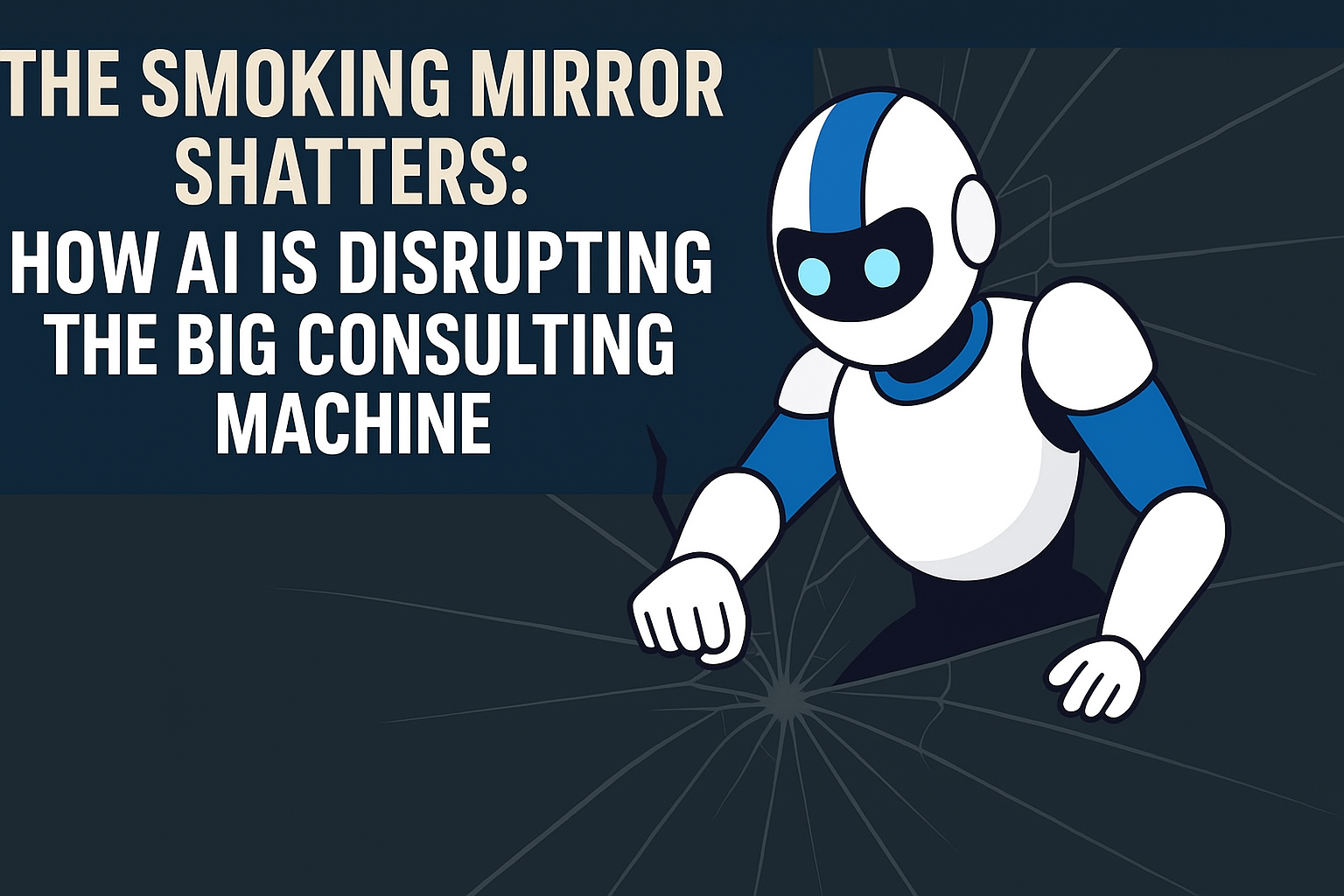For decades, Big Consulting has operated behind polished PowerPoint decks, premium research reports, and insider government access. Firms like McKinsey, Booz Allen Hamilton, and Deloitte have built billion-dollar pipelines convincing agencies and Fortune 500s alike that strategic insight must come from six-figure engagements and elite whitepapers.
But the mirror is cracking.
And this time, the smoke is clearing.
The Rise of Agentic AI—and the Fall of the Research-Industrial Complex
Let’s start with the irony: while McKinsey publishes ambitious thought pieces like “Seizing the Agentic AI Advantage”, they simultaneously urge caution around AI disruption—while building AI services and monetizing the trend.
Why? Because they know that their most profitable deliverables—strategic insights, whitepapers, and frameworks—are now replicable by LLMs in minutes.
With GPT-4o, Claude, or Gemini, you can generate a deeply researched, tailored strategy doc in under 20 minutes, for the price of a decent coffee.
Not Starbucks money. Café money.
Meanwhile, the Big 5 are still selling research reports for $250,000+, often outdated by the time they hit your inbox. Don’t worry the invoice will not be outdated…
AI Is Not Just Writing About the Work—It’s Doing It
I’ve seen it firsthand.
Years ago, my team built a full-spectrum Computer Network Operations (CNO) platform for cyber offensive missions. It worked. It scaled. It delivered. Meanwhile, our consulting competitors were still in Phase 0—making decks to describe what success might look like.
One agency brought in a major consulting firm to “enhance” our working system. Behind closed doors, they admitted what we already knew: our $3M self-funded platform was a painful reminder of their $100M PowerPoint project, with nothing to show but well-designed slides and polished tables.
They walked away from us, not because our platform failed, but because it succeeded. Too well. It made their $100M pitch deck obsolete. That kind of truth is dangerous in bureaucratic circles. So instead, they circled the wagons. Claimed success. Handed out awards. And several individuals were promoted for vaporware.
Then came the real blow. Years later, an employee from that same firm leaked the platform’s classified code to the dark web. National security risk? Sure. But the response? Business as usual. Just bring in a few more SESs and flag officers and reset the narrative. No accountability. No loss of access. No missed contracts.
We didn’t win that battle. And it was an expensive lesson about how innovation actually works—and how it doesn’t get rewarded.
We didn’t start with storyboards or business development fluff.
We started with outcomes.
We built first. Documented later. That’s how real innovation happens.
But that’s not how it gets funded. That’s not how it gets protected. That’s not how it gets rewarded.
In another example, we were asked by a research organization to submit a white paper outlining this same platform—months after we had briefed them directly. Turns out, they used our ideas to shape a “competition” that was eventually awarded to a defense contractor… that had recently hired several of their senior staff.
I won’t pretend we weren’t frustrated. But we pivoted.
We weaponized the same platform for automated penetration testing—one of the most critical and lucrative areas of my business. So in the end, we didn’t just win.
We built something real. Something that worked. And no PowerPoint can compete with that.
The Power Structure No One Wants to Call Out
Inside the Beltway and across the Fortune 500, the same consulting firms play both sides: they write the RFPs, shape the technical requirements, then win the contracts they architected.
When failure happens—like the U.S. Army’s massive credential exposure years ago—accountability is muted. Instead, these firms hire SESs or flag officers, give them cushy roles, and act like nothing happened.
Weeks later, that same firm wins another $100M contract on—wait for it—identity and cyber management for the Army.
This is more than broken procurement. It’s political engineering disguised as systems engineering. It is more powerful than even the K Street bandits, although they are usually part of this “engineering.”
For mid-sized or small tech firms, it’s nearly impossible to compete when:
- The research phase is a Trojan horse for larger deals, and it is usually the organization’s employees who open the door first.
- Your employees are poached – remember they are allowing the larger primes to have better billing rates and positions, so of course employees would like to do the same job and be paid more – who could blame them?
- And “small business participation” is a smokescreen – they allocate it so they do not have a full-on internal war of massive leaks of this political engineering, although I imagine the US public has caught onto this, and is starting to ask more questions and, more importantly, question the process.
Sure, there are formal firewalls and carefully crafted OCI (Organizational Conflict of Interest) language. But when a firm has a revolving door of SESs (and lower sometimes), flag officers, and senior consultants flowing in and out of government and industry, those “walls” aren’t walls at all—they’re curtains. Thin Temu level ones.
Let’s be honest: this isn’t just inefficient. It’s corrosive.
Yet, paradoxically, there is a silver lining—but not because the system works. It’s when bold leaders inside government or enterprise break ranks and recruit the real talent from these firms. Not the PowerPoint generalists. The builders. The doers. The ones who are quietly suffocating under endless decks and BD meetings.
When those individuals are finally given a chance to work on real-world missions and not just “capability statements,” they become transformational assets. They move fast. They solve the hard problems. They become the engine for innovation inside organizations that were previously stuck in consultancy cycles.
So yes, the system is broken. But sometimes the escapees from the system become the ones who fix it.
AI Changes the Equation—Permanently
Agentic AI isn’t here to replace people – unless you can only do PowerPoints (never mind you can do many more quickly with AI – you are also safe). It’s here to replace inefficiencies.
You don’t need to spend millions on “visioning documents” when an internal AI agent—securely connected to your data—can generate:
- Custom research based on your data
- Threat assessments
- Market analysis
- Competitive intelligence
… in minutes. Note – most of your competitors have already uploaded their most sensitive documents to AI to make their emails and presentations look better. Now you have insights you could never imagined available.
Ask yourself:
Could this research be done in-house by an AI architect using your internal systems and secure agents?
Could that $500K report be replaced by a $15 API call plus a domain-aware prompt?
The answer is almost always: Yes.
It’s time to invest in AI Agent Farms, internal models, and zero-trust data infrastructure.
Yes, you’ll still need PowerPoints and PDFs—but AI can generate those too, in record time.
The Smoking Mirror Is Cracked—Now Walk Through It
The consulting giants won’t vanish overnight. Their relationships and Rolodexes are still strong. But the mystique is gone.
Their secret sauce is now a public recipe.
Your best business decision might no longer come from a $500K strategy doc—it might come from a prompt and a secure connection to your internal data.
If you’re still overpaying for insights, you’re not just wasting money—you’re missing the future.
Final Thought: Stop Buying “Intelligence.” Start Building It.
With AI, any organization can build its own context-aware, real-time intelligence system—and outperform overpriced research reports written by outsiders with no stake in your mission.
It’s time to close the trapdoor we’ve built around big-budget research.
And open the front door to AI-powered, in-house innovation.
Waylon Krush is CEO of ZeroTrusted.ai, a cybersecurity company focused on AI security, privacy, and reliability. A US Army veteran, former CEO of Lunarline, and builder of operational platforms for the DoD, IC, and Fortune 500s, he speaks frequently on Cyber Security, Privacy, and unlocking secure innovation with AI.
Follow Waylon on LinkedIn or subscribe to ZeroTrusted.ai updates.






Comments